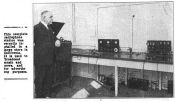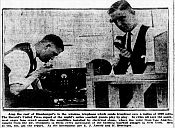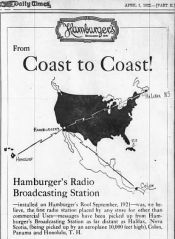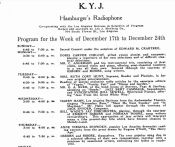|
www.theradiohistorian.org
Copyright
2023 - John F. Schneider
& Associates, LLC
[Return
to Home Page]
(Click
on photos to enlarge)

This image shows the complete installation of station
6XAK in Hamburger's Department Store, as published in "Radio News",
December, 1921.

E. J. Arnold and H. Berringer operate the
transmitter of station 6XAK; "Los Angeles Evening Record", October 8,
1921.

This advertisement was placed in the "Los Angeles
Times" on April 1, 1922.
Oliver Garretson and Charles Austin are seen
here making a KYJ broadcast, dated June 15, 1922.

This program schedule for KYJ appeared in
"Radio Doings" Magazine on December 16, 1922
|
|
The KYJ Story:
This
5-watt radio station was owned by the Leo J. Meyberg Company and had a
‘studio’ on the top floor of the M.A. Hamburger's Department Store
(which became the May Company in 1923). The store was located at
the corner of 8th and Broadway in downtown Los Angeles. KYJ was
also known as “Hamburger's Radiophone.” 1
Licensed: December 9, 1921 (Earlier: 6XAK October 1, 1921)
Final broadcast: December 31, 1922
License Deleted: May 1, 1923
Transmitter power was 5 watts initially, and increased to 50 watts on
April 27, 1922.
Frequency history:
833 kilocycles/360 meters December 9, 1921
833 kilocycles and 619 kilocycles (485 meters) March 22, 1922
(485 meters was used at the time for weather and market reports only)
6XAK:
The Hamburger Radiophone began broadcasting on October 1, 1921, as 6XAK
on 310 meters or about 968 kilocycles. The station was built and
installed by Mr. E.G. Arnold and Hall Berringer, who was sales manager
of the Western Radio Electric Company. This company also owned station
6XD (later KZC/KOG), which Berringer called “the first broadcasting
station in Southern California." In the Los Angeles Evening
Express on September 30, 1921, a story on 6XAK reported that Mr. Arnold
and Mr. Berringer were both radio engineers of the Leo J. Meyberg
Company. The Hamburger’s store used their new radiophone station
to broadcast music and news, and for advertising purposes; especially
to sell phonograph records and the radios and radio parts that were on
display in the store's radio department. Many other Los Angeles radio
supply stores and electrical stores would also soon start a small radio
station to promote their business and encourage interest and sales of
radios and related equipment. The “wireless concerts” transmitted by
the Hamburger’s radiophone station were publicized often in more than
one Los Angeles newspaper.
In the October 15, 1921 edition of “The Talking Machine World,” a small
item on page 101 describes the wireless broadcasting station on
Hamburger’s roof: “Harry N. Briggs, general manager of the music
department at Hamburger’s has arranged for the transmitting by wireless
of the six latest Brunswick records daily at 3 p.m. and 8 p.m., from
the roof of Hamburger’s Department Store. The records are played
on a Brunswick phonograph and announcement is made by the
operator. The wireless is an extremely powerful instrument and
operates at a radius of 1,500 to 2,000 miles.”
Three months later, “The Talking Machine World” from January 15, 1922
printed a similar article about the wireless phonograph concerts from
Hamburger’s Department Store in Los Angeles helping to increase sales
figures in its phonograph department. Quoting from the story, it
reads, “A short time ago, wireless operators, both amateurs and
professionals were surprised to get the following announcement through
their receivers: “This is experimental station 6XAK speaking,
Hamburger’s wireless station, located on the roof of the store.
Commencing today and continuing for an indefinite period, there will be
various concerts and other announcements. We will now have a
selection from the phonograph.” Then followed one of the latest
records, and thousands of radio operators listened in while Hamburger’s
gave a concert lasting from 4 to 5 p.m. Announcement of the new
service was made in the papers with the statement that in addition to
the afternoon concerts, the store will give concerts on Monday,
Wednesday and Saturday nights, from 8 to 9 o’clock, and will later
establish a service between 8 and 9 o’clock in the morning.”
Every afternoon from 4 to 5 p.m., the store sent out a “free radio
concert” for the increasing number of people with radios. By
October of 1921, the fame of the Hamburger radio station had spread so
quickly, that when the Scotti Grand Opera Company was in Los Angeles,
four famous opera singers looked for the store, and arranged to sing
into the 6XAK transmitter. Advance publicity of the event
resulted in thousands of radio listeners tuning in that day. The
station also broadcast results each day of the 1921 World Series to
Southern California baseball fans. When the U.S. Department of
Commerce began to license radio stations for the purpose of
broadcasting music, news, talks, etc. to the general public, 6XAK
applied and became radio station KYJ on December 9, 1921.
KYJ:
Bertam O. Heller was KYJ’s first engineer/operator, but he later left
KYJ to get KWH on the air for the Los Angeles Examiner, and became that
station’s chief engineer. Oliver S. Garretson, an amateur
radio operator and wireless pioneer in Southern California, rebuilt the
KYJ equipment and became chief engineer for a few months. He
increased KYJ’s power from 5 to 50 watts on April 27, 1922.
The Los Angeles Evening Express newspaper joined with station personnel
to select the programming. One schedule for KYJ in late-1922
shows that it was on the air seven days a week. The station was
typically on the air for 1 or 1-1/2 hours in the afternoon. The
station came back on for 45 minutes in the evening. The listening
public of the day tuned in to hear a variety of talks and music.
One program schedule shows that KYJ aired operatic soloists, a singing
comedian or saxophone artist, both from vaudeville; readings of
materials from editors of top magazines of the day; and even a talk by
the store's radio operator Charles Austin, "giving an authoritative
discourse on an interesting phase of radio receiving."
Southern California resident Jack Bascom of Glendora told me in a 1990
letter that when he was 13 or 14, he visited KYJ while they were on the
air. It was in mid-afternoon, and people in the store could watch
the KYJ broadcast through a window and listen to the broadcast over the
outside speakers. A few rows of chairs were placed on the other
side of the window for the visitors. On the same floor, customers could
look at the displays of radios and radio parts for sale.
In addition to the radio department on the 4th floor, the store also
had its own radio school. The subjects taught included classes in radio
theory, Morse code, how to become an amateur radio operator, etc.
KYJ, like other small short-lived stations that were broadcasting
during 1922 in Los Angeles, was well remembered by other "old-timers"
many years later. Wallace Wiggins was chief engineer and co-owner
of KREG/KVOE in Santa Ana in the 1930s and '40s, after working at KHJ
and KGFJ. In a 1974 oral history interview with Cal State
Fullerton, Wiggins remembered KYJ as one of the first stations he
listened to on a crystal set in 1922. George Farmer, W6OO, wrote
in his book "Radio Almanac", about picking up the KYJ signal aboard a
ship he worked on as a wireless operator in 1922. Adding to the
KYJ memories in later years, in 1950, Ed Stodel, owner and president of
Stodel Advertising Company in Los Angeles, talked about his early
interest in radio broadcasting. He told Broadcasting magazine
that he was 12 years old in 1922 and built his first crystal set.
Stodel remembered that when a radio station was off the air on certain
days, he used to telephone the Hamburger’s Department Store and request
that they put KYJ on the air, so he could hear their music.
Station owners in 1922 learned quickly that radio could be used to
discuss important issues. In early April of 1922, W. L. Pollard,
who was in charge of KYJ, told the Los Angeles Times he was giving a
half-hour of air time to an attorney opposed to a state bond measure on
the November 1922 California ballot. The April 6th talk went out on the
500 meter wavelength, which was allowed by a special permit from
Washington, instead of the usual 360 meters, from 9:00 to 9:30
p.m. Since then, local and national politics have filled
countless hours of radio air time.
One example of how a radio station's signal could travel quite far in
the un-crowded broadcast band in those days is a letter KYJ received in
mid-April, 1922. It was a reception report from a listener in
Halifax, Canada, more than 3,500 miles away! The Los Angeles
Times reported that the letter correctly quoted the names of the
phonograph records played on a March 24th broadcast. Owner Leo J.
Meyberg said, "Of course, this represents a freak result, particularly
as the station was operating at 5 watts and a radiation of 1.6
amperes. Atmospheric conditions must have been nearly perfect to
have made the reception at Halifax possible. However, we have received
similar reports from the Panama Canal Zone." An ad in the April
1, 1922 edition of the Times also indicated that KYJ's signal was
received in Honolulu!
The time-sharing agreements on 360 meters didn’t always work out in the
best way for listeners trying to hear a particular station at a certain
time. In the Los Angeles Times of July 27, 1922, the radio page
printed some letters from the 64 letters received from radio fans with
general complaints about local broadcasting stations. One Los
Angeles writer complained about interference caused by two stations on
the air at the same time on 360 meters. The writer didn’t think
anyone could tune his radio set to separate KLB Pasadena and KYJ Los
Angeles. T.M. Simpson wrote, “KLB got on the air about one minute
before KYJ and was doing fine and delivering a fine program, and
immediately KYJ came on, and from the sound of things, they must have
had a thousand watts on their tubes and that settled it. Then we
listened in to such announcements as the following: “Our next
offering will be a fox trot, “By the Silvery Nile” by the Isham Jones
Orchestra,” followed by “Our next selection will be “Blue Bird Land,” a
fox trot by the Isham Jones Orchestra.” Other letters also
complained about playing phonograph records over the air.
Four months later, the radio department of Hamburger’s Department Store
told the Evening Express newspaper about interference from other
stations. The radio page from November 8, 1922 started this
way: “Complaints have been received by the radio department that
broadcasting stations working off their scheduled time on 360 meters
last week, interfered with programs being broadcasted from KYJ.
Notices of this sort are repeated to the erring station with the
request that they keep the schedule agreed upon. If such
interference takes place again, KYJ would appreciate being notified at
once.”
By December of 1922, their final month on the air, KYJ was using mostly
live talent during all broadcasts. In Radio Doings of December 17
to 24, 1922, the KYJ program schedule indicated the station was on the
air 7 days a week from 6:45 to 7:30 p.m. Monday through
Saturday, KYJ was on the air 3 to 4 p.m. and some days from 3:30 to 5
p.m. There were several instrumental performers, mainly on
piano and violin. One evening, the entertainment was from a
saxophonist and a pianist, who offered “Jazz From the Great White
Way.” The next night, another jazz orchestra performed through
the courtesy of two songwriters. A song duo from vaudeville
appeared one night and a concert baritone from the Ambassador Theatre
in Los Angeles sang another evening. During the half hour from
4:30 to 5 p.m. on a Tuesday afternoon, the broadcast featured “A
reading of special radio articles by the associate editors of “Vogue,”
“Vanity Fair” and “House and Garden.” KYJ listeners also heard an
actress from the local theater reading extracts from a drama by Eugene
O’Neill, during a Thursday afternoon broadcast.
For various reasons, KYJ could not make a go of it, even though it
seemed to be popular with listeners of the day. Without commercials to
pay for operational costs, the sale of radio sets apparently was not
enough to keep the station on the air, or perhaps the owner lost
interest in the project. 2
On Friday, December 29, 1922, the Los Angeles Evening Express reported
that KYJ, the “Express-Hamburgers Radio Station,” would be going off
the air for good. The decision was made by the Leo J. Meyberg
Company, the owners of KYJ radio. A “goodbye program” was
broadcast on Saturday, December 30th, which included the playing of
“Taps.” The newspaper reported that the schedule for KYJ that day
included speeches by officials of the Hamburgers store and KYJ
announcers and engineers. KYJ’s final one-hour broadcast on 360
meters/833 kilocycles, took place on Sunday, December 31, 1922.
This 50-watt broadcasting pioneer that entertained early Los Angeles
crystal set and radio owners for approximately 14 months, signed off
for the very last time. Because the Evening Express did not
publish a paper on Sundays, there was no coverage of KYJ’s last
broadcast and I couldn’t find any mention of the ending of this radio
station in their Monday January 1, 1923 edition. It seems that
other Los Angeles newspapers also ignored the situation. I found
however, that the Evening Express radio schedule continued to list KYJ
times on the air for several days, after the station signed off for
good.
In the January 6, 1923 edition of Radio Doings, it was announced that
the Hamburger’s store had discontinued broadcasting. But the Leo
J. Meyberg Company, which owned and operated KYJ, was to broadcast from
their studio via phone line over KFI at a later date. KYJ's
station license was deleted by the Dept. of Commerce on May 1,
1923. Some of the information on the history of KYJ was gathered
from a December 1921 story in the magazine Radio News.
FOOTNOTES:
1 At
the same time, the Meyberg Company
operated station KDN in the Fairmont Hotel in San Francisco.
2 A
possible reason for the closing of both KYJ and KDN in San Francisco
was the death of Sheldon Peterson, who was said to be the driving force
behind the stations. Mr. Meyberg, the company President, was primarily
interested in the sale of lighting fixtures and associated electrical
equipment. He had little real interest in the stations, and lost the
desire to operate them after Peterson's death.
|